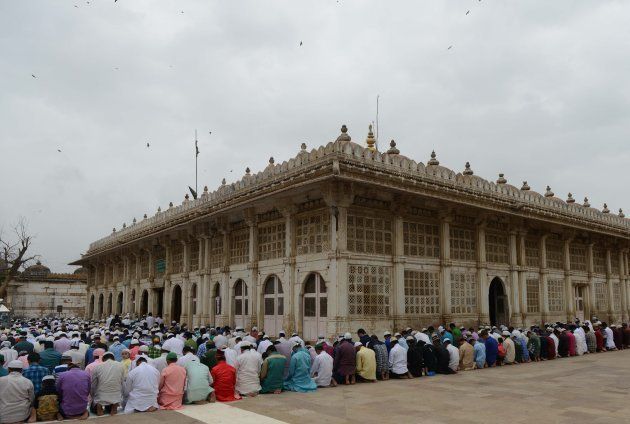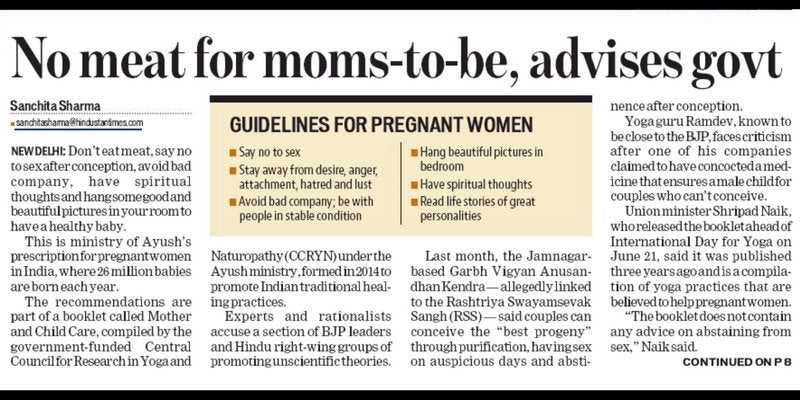
The declaration by UNESCO of Ahmedabad as India's first World Heritage City is a fruition of a process of image-makeover initiated in 2010 by now Prime Minister Narendra Modi in his capacity as Gujarat's chief minister.
Part of his personal and political recasting, best understood with the benefit of hindsight as a necessity in his march to Raisina Hill, the decision to make a bid for this recognition was meticulously planned because it enabled Modi's self-projection as a leader with concern for his state's heritage and culture. Yet, the irony cannot be missed that the heritage which is being selectively celebrated is unidimensional.
Ahmedabad's syncretic past, which has been steadily underplayed and even undermined in the recent decades, has found no mention since the tweet by Ruchira Kamboj, India's permanent representative to the UNESCO, announcing the decision on Saturday.
Every congratulatory statement made by the prime minister down to his party president Amit Shah to the current Gujarat chief minister Vijay Rupani and other state BJP leaders emphasised the built heritage, the buildings and pols (or neighbourhoods) of the six-century-old city. Sadly, the community heritage, as well as the social, cultural and spiritual heritage of a significant section of its people, was ignored.
This is typical of the tendency to overemphasise Gujarat's (as well as the state capital's) Jain, Vaishnav and Mahajan traditions even as deathly silence prevails on its Islamic heritage—in spite of the fact that Muslims comprise 9.67% of the state's population, 14.75% of the statewide urban population and 12.24% in Ahmedabad alone. Making no mention of Ahmedabad's composite heritage is therefore suggestive of a deliberate attempt to appropriate one feature, while eliminating another.
Muslims comprise 9.67% of the state's population, 14.75% of the statewide urban population and 12.24% in Ahmedabad alone
That the UNESCO's declaration has come six years after the submission for inclusion was made, that too in a year when state elections are due, is probably sheer coincidence. While few can grudge the BJP for milking this 'achievement' during the polls, there is no denying that the official rhetoric will further the political agenda of the ruling party in the state. The honour bestowed on Ahmedabad is soon likely to be projected as another instance of reinforcing Gujarati asmita, or pride, which marked the beginning of the Modi era.
In its citation note, UNESCO talks of the city, founded by Sultan Ahmad Shah—from whom its name is derived—in the 15th century, as having "a rich architectural heritage from the sultanate period", which includes "numerous mosques and tombs as well as important Hindu and Jain temples of later periods".
A short documentary on the city embedded in a tweet by Chief Minister Rupani depicts the city as having the following attributes: "truly secular (sic) Islamic structures (it does not elaborate what exactly these are: mosques, palaces, tombs or just public spaces), Hindu and Jain temples, unique minarets (note the choice of the adjective) ... tombs and pols(juxtaposes places of dead with the living and not different communities of the living) exists with calm serenity (sic)".
At the Teen Darwaza, a major historical landmark of the city, the voiceover, laid over visuals showing a man, obviously Muslim, lighting the customary lamp, says: "This little lamp of hope is an example of unity." (It's one community's responsibility alone to maintain harmony.) Elsewhere in the movie, over a short montage sequence, the following words flash: Brotherhood, Coexistence, Harmony, Simplicity, Tranquillity. In a city that is yet to exorcise the ghost of 2002, the jury will probably have a different take on whether any of these words exist in practise among the communities living there.
Chroniclers of the old city that has now grown—like most cities in India—into an unmanageable urban sprawl and a sea of chaos have long spoken of the flight of the people. While among the Muslims the migration from the old city was necessitated by insecurity since 2002, among Hindus it has grown as gentrification of the old city resulted in crass commercialisation and people began to seek 'modern' surroundings and amenities. That this process is unlikely to end is evident from the assertion of state government and BJP top guns that the UNESCO listing is going to boost tourism in Gujarat.
Ahmedabad will draw more tourists because of its composite architectural heritage but its amalgam of culture will be further relegated to the background. "It's a bit like the Gujarati thali," says Tanishka Kachru, a professor at the National Institute of Design. What goes around as 'Gujarati cuisine' now is not the food of all communities—the diversity has disappeared from the plate. It takes considerable effort for visitors to Gujarat to locate places where non-vegetarian food, the staple of Muslims and several other communities, is available. Moreover, there is considerable divergence in vegetarian Kathiawadi cuisine as well, but the ubiquitous thali serves food patronised mainly in areas in and around Ahmedabad.

The erasure of Gujarat's culinary diversity is akin to how Ahmedabad's demographic compositeness has been pushed out to what the city's biographer Amrita Shah describes as "the strap"-like apparition towards the bottom of its map. This strip of colonies, starting from the south-western fringe of Juhapura to several other localities to well into the highway that takes one to places south of Ahmedabad, also demarcates the informal border on the side of which more and more Muslims continue to resettle for reasons of security and alienation.
Modi's political makeover began in 2010 after the Tata Motors' decision to make Sanand the home for the Nano small-car factory in October 2008 triggered a cascade of investments in Gujarat. In 2010, Modi also visited the Sarkhej Roza, the Islamic monument on the outskirts of the town that Sultan Ahmed Shah built as a tribute to Shaikh Ahmed Khattu Ganj Baksh, a Sufi saint. The visit was part of the annual Ahmedabad Heritage Week. The pitch for listing the city with UNESCO was made around the same time.
Yet, the shrine of the Sufi saint mostly remains what it was—a place with a dried-up pond, vandalised walls with street lumpens expressing frustration at unrequited love and floors littered with every piece of scrap one can imagine. Except for those few days in the year when the city's glitterati arrive in swanky cars for the 'festival'.

In 2011, Modi launched the sadhbhawna programme that botched LK Advani's plans for another yatra which, he had hoped, would enable him to take a shot again at the post that had eluded him for two decades. But in all his reach-out initiatives, Modi ignored diversity—demographic, cultural, literary and spiritual—and never especially mentioned those on the margins by intelligently publicising that he was the leader of the metaphorical 'sabka' (everyone).
Though Ahmedabad has got its recognition in due measure for "being a cradle for the non-violent freedom struggle for India led by Mahatma Gandhi" and because of "the secular coexistence of Islamic, Hindu and Jain communities within the city," these attributes, especially the latter, still find little mention in the official discourse.
While the city's Islamic architectural heritage is being showcased, it is also simultaneously appropriated or claimed as their own by the elite. The community that used these buildings, their people, their culture and their spiritual traditions finds no mention in this rebranded 'heritage city'. This has happened in the past too, and not just with Muslims, but with others who lived on the margins of society as well.

When the much-touted Sabarmati riverfront project was designed, no consideration was given to artisans and traders who sold their wares in the Sunday market, Ravivari, from the same place that their ancestors had for around 600 years. Because political events post-2002 resulted in two decades of a lack of sharing of heritage, it is now being propagated that such partaking had never been a practise among the people. Not just the people, even physical landmarks and heritage sites have been destroyed in the rush to 'jazz up' the city. The Kankariya lake, also dating back to the 15th century, is a pathetic imitation of its old self and the love for concrete represents the desire for 'order' among the political elite.
Despite the gloom, Shah still considers this a "good moment" for Ahmedabad because it provides an opportunity to "treasure the city" and a window to highlight "values of peace and secularism" that were once part of its essentials. An opportunity has been presented to enable Ahmedabad to rid itself of a contemporary identity layered with questionable politics. A concerted campaign may even enable the city to rediscover its lost past.
Restoring vanished discourse and tradition is undoubtedly an uphill task, but this opening is up for grabs. If this opportunity is not used, Ahmedabad may well become a 'world class' city but with selective heritage. And that might set the stage for what the ever-combative Subramanian Swamy tweeted in an echo of an old demand of the sanghparivar: 'Ahmedabad will become truly heritage worthy when its name is changed back to Karnavati'.
Also on HuffPost
